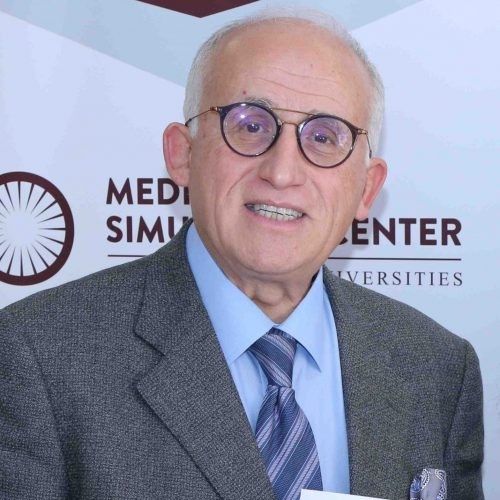Study Compares Postoperative Thrombosis Incidence for Branded, Biosimilar Enoxaparin
There was no statistically significant difference in postoperative thromboembolic events and incident heparin-induced thrombocytopenia among patients treated with branded versus biosimilar enoxaparin.
Chadli Dziri, MD
Credit: LinkedIn

Treatment with branded and biosimilar enoxaparin in patients who underwent an operation for digestive cancer showed no difference in the occurrence of postoperative thromboembolic events and incident heparin-induced thrombocytopenia.
Among a cohort of nearly 200 patients who underwent gastrointestinal cancer surgery at a hospital in Tunisia, 6 had subclinical venous thrombosis and a single participant had heparin-induced thrombocytopenia, with no statistically significant differences in incidence observed between treatment groups.1
“Our RCT is the first to compare [branded enoxaparin] with [biosimilar enoxaparin] on an asymptomatic thromboembolic event as the primary endpoint, while controlling for adverse events,” wrote Chadli Dziri, MD, professor emeritus at Tunis El Manar University, and colleagues.1
Although the exact prevalence of deep vein thrombosis or pulmonary embolism is unknown, the US Centers for Disease Control and Prevention estimates as many as 900,000 people could be affected each year in the United States. Hospitalization, surgery, and cancer are known risk factors. Enoxaparin is effective for preventing venous thrombosis, although the comparative safety and efficacy of its branded and biosimilar variations in patients undergoing surgery for digestive cancer have not been explored.2
To compare the prevention of postoperative thrombosis events in patients treated with branded enoxaparin and biosimilar enoxaparin, assess treatment tolerance, and identify independent predictive factors of thromboembolic incidents, investigators conducted a prospective, comparative, randomized controlled trial in a single-center surgical department at Charles Nicolle Hospital in Tunisia between October 12, 2015, and July 8, 2020. Patients > 18 years of age with diagnosed digestive cancer who underwent emergency or elective surgery were included in the study and assessed for any asymptomatic thromboembolic event after surgery.3
In total, 168 patients were enrolled in the study and assigned to receive treatment with branded enoxaparin 4000 IU one injection per day for 30 days (n = 81) or biosimilar enoxaparin 4000 IU one injection per day for 30 days (n = 87). The injections were administered subcutaneously 8-12 hours after the surgery. In the branded enoxaparin group, the mean age was 59.9 (Standard deviation, 11.8) years and 55.6% of patients were male. In the biosimilar enoxaparin group, the mean age was 60.3 (SD, 12.9) years and 44.8% of patients were male.1
The primary endpoint was any asymptomatic thromboembolic event, assessed by a systematic Doppler ultrasound of the vessels of the lower limbs between days 7 and 10 post-surgery. Of note, this evaluation was done in a blinded fashion and the sonographer was not aware of patients’ randomization. Secondary endpoints included the occurrence of a symptomatic thrombotic event, the occurrence of incident heparin-induced thrombocytopenia, the occurrence of bleeding events, and mortality.1
Investigators pointed out there were no statistically significant differences in patients’ demographic and thrombosis factors between the treatment groups. A total of 145 patients were systematically evaluated by Doppler ultrasound of the vessels of the lower limbs between days 7 and 10 post-surgery. Subclinical venous thrombosis was observed in 6 (4.1%) patients, including 4 (5.6%) patients in the branded enoxaparin group and 2 (2.7%) in the biosimilar enoxaparin group without statistically significant difference (P = .435).1
In the branded enoxaparin group, 7 (8.6%) clinical and subclinical events were reported compared to 6 (6.9%) in the biosimilar enoxaparin group (P = .672). Investigators noted there was a slightly longer duration to thrombosis among those treated with biosimilar enoxaparin (9 days), whereas the median time to thrombosis was 8 days among those treated with branded enoxaparin (P = .160).1
Investigators assessed the difference in means using Student’s t-test. Results showed the interval of the difference in means was [-0.095 +0.036], which they pointed out was included in the interval [-0.20 +0.20], confirming there was no significant difference between biosimilar enoxaparin and branded enoxaparin for preventing thromboembolic events.1
Postoperative complications were prevalent among 14 (17.3%) patients in the branded enoxaparin group and 8 (9.2%) in the biosimilar enoxaparin group (P = .120). No incident of heparin-induced thrombocytopenia was observed in the branded enoxaparin group and a single incident occurred in the biosimilar group (P = 1.000). There were 6 deaths in the branded enoxaparin group and 11 deaths in the biosimilar enoxaparin group, although investigators pointed out the difference was not statistically significant (P = .261).1
“Our randomized clinical trial showed that there was no statistically significant difference between [branded enoxaparin] and [biosimilar enoxaparin] groups in the occurrence of postoperative thromboembolic events. There was no statistically significant difference between [branded enoxaparin] and [biosimilar enoxaparin] groups regarding incident heparin-induced thrombocytopenia. No predictors factors of postoperative thrombosis after digestive oncology surgery were identified,” investigators concluded.1
References:
- Drizi C, Hmida WB, Dougaz W, et al. Biosimilar versus branded enoxaparin to prevent postoperative venous thromboembolism after surgery for digestive tract cancer: Randomized trial. PLOS ONE. https://doi.org/10.1371/journal.pone.0293269
- US Centers for Disease Control and Prevention. What is Venous Thromboembolism? Venous Thromboembolism (Blood Clots). June 28, 2023. Accessed December 5, 2023.
- Clinicaltrials.gov. Comparison of Thromboembolic Events in Patients Undergoing Thromboprophylactic Treatment With ENOXA® vs Lovenox® (ENOXACARE). July 29, 2021. Accessed December 5, 2023. https://clinicaltrials.gov/study/NCT02444572